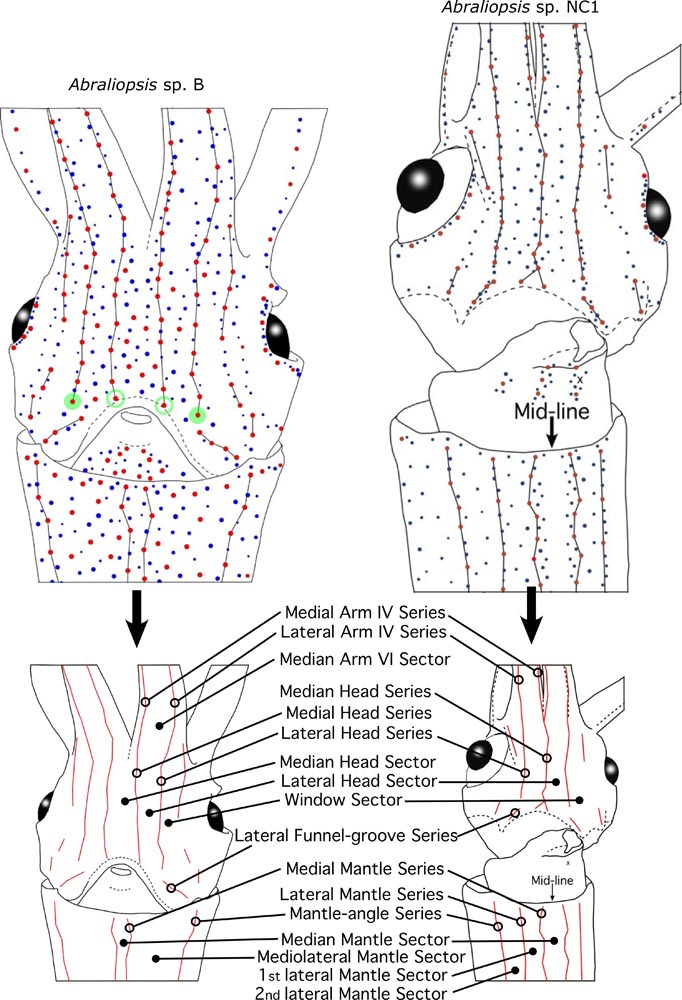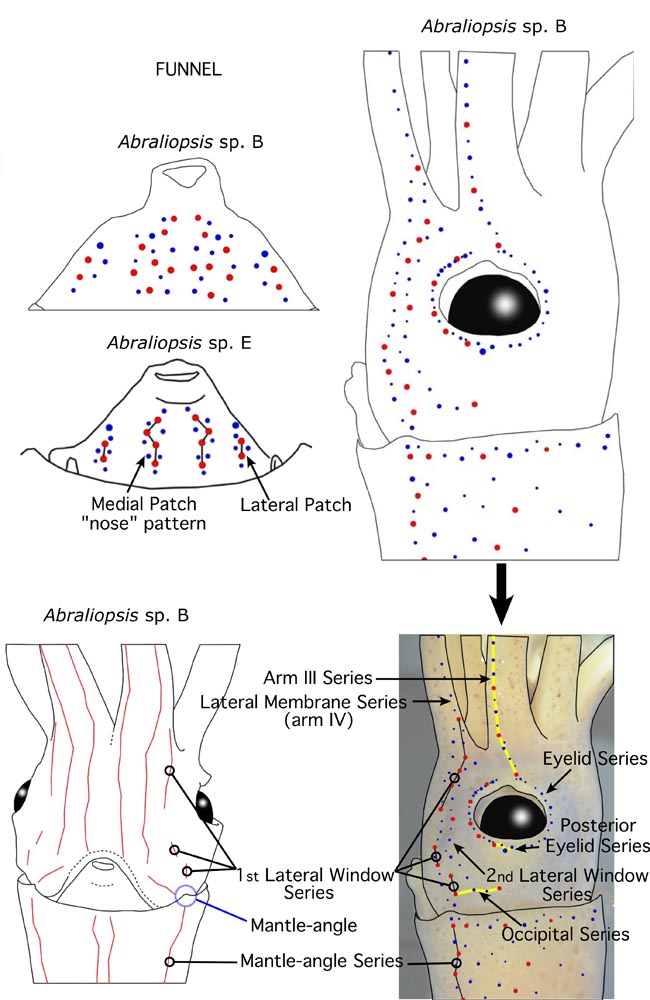The photophore terminology used here is largely based on the distribution of complex photophores (ie, red dots below; henceforth called "red" photophores) and to a much lesser extent on non-complex photophores (ie, blue dots below; henceforth called "blue" photophores). The success of this method relies on the ability to accurately distinguish between the two categories of photophores. While this is easily done for most photophores there are always a few where the decision is difficult due to red photophores in developmental transition, damaged state , unusual physiological state or etc. The patterns discussed here do not include the photophores of the funnel groove which form a separate category of "white" photophores with a very consistent arrangement and unknown function. Therefore be careful not to confuse "white" photophores with the "red" and "blue" photophores located adjacent to the funnel groove.
Patterns can be difficult to detect in Abraliopsis (Abraliopsis) spp. but easier in other subgenera, although in the latter the presence of numerous "blue" photophores in the sectors between "red" photophore series can give the false impression, on casual examination, of a scattered arrangement of photophores.
The lines drawn below for Abraliopsis sp. B (as in all members of Abraliopsis (Abraliopsis)) below are somewhat arbitrary. We begin by showing how we drew the lines.
- Medial Head Series - Locate the two, bilaterally placed, posterior-most complex photophores lying on the anterolateral edge of the funnel groove (indicated by green rings below). Next draw lines connecting "red" photophores while maintaining as straight a line as possible and incorporating as many "red" photophores as possible (there is a trade-off between these goals) until reaching the Medial Arm IV Series. Note that this series is determined only by "red" photophores although many "blue" photophores lie on or near this line. While determination of the number of photophores included in this line is somewhat arbitrary in A. (Abraliopsis) spp., the starting and ending points are not.
- Lateral Head Series - Locate the most posterior of the red photophores medial to the Window Sector (the sector that contains the ventral window covering the eye through which the ocular photophores can usually be seen) (each of these photophores is indicated by a large green dot below). This lies anterior or anterolateral to the most anterior "red" photophore of the Lateral Funnel-groove Series. From this photophore, connect the "red" photophores until joining with the Lateral Arm IV Series, using the same rules as in forming the Medial Head Series. As drawn here, this series leaves a total of 4 "red" photophores in the Lateral head sectors. If nothing else, this method aids in determining the number of photophores in the central head region.
The remaining series are readily apparent and will differ a bit between subgenera. Those that need comment are as follows:
- Median Head Series (absent from species in Abraliopsis (Abraliopsis)) - This series divides anteriorly into the Medial Arm IV Series. Posteriorly it also divides to form a caret (inverted V). The number of "red" photophores in the caret (typically 3 or 6) is an important specific character.
- Medial Head Sector - The number of "red" photophores in this sector is an important specific character in the subgenus Abraliopsis, and the relative abundance of "blue" photophores in this sector is an important specific character in other subgenera. When the Medial Head Sector is subdivided by an additional photophore series, the terminology follows the mantle terminology.
- 1st Lateral Window Series - This series lies immediately lateral to the eye window and contains two or three discontinuous lines of "red" photohores often separated by a gap of linearly arranged "blue" photophores. Anteriorly this series is continuous with the Lateral Membrane Series of arms IV.
- 2nd Lateral Window Series - This series is not always present. When present it lies immediately lateral to the 1st Lateral Window Series and consists mostly of "blue" photophores with at least 4 "red" photophores.
- Eyelid Series - Always present. Surrounds the eye opening with a small gap anteriorly and posteriorly in the mid-lateral line of the head. One portion of the Eyelid Series is the Posterior Eyelid Series which includes both red and blue photophores. It extends from the most posterior red photophore of the Eyelid Series to the posterior gap in this series. It includes one or two large posteriorly displaced blue photophores and terminates with the smaller of the latter two (or its counterpart). The sequence of photophores in the Posterior Eyelid Series is written in the same manner as that of the Occipital Series. For example in the drawing below this Series is written as "RbBB" which stands for Red, small blue, big displaced Blue, smaller large-Blue (may or may not be displaced).
- Lateral Funnel-groove Series - Always present. Number of "red" photophores appears to be a specific character although the numbers can change with squid size.
- Occipital Series - Begins with most posterior large "red" photophore of the 1° lateral-to-window series and parallels the occipital crest. This series includes of "red" and "blue" photophores whose numbers and arrangement are an important specific character. The sequence red-blue-blue-red (as seen in Abraliopsis sp. B below - side view of head) are written as: RbbR. In some species (especially members of subgenus Abraliopsis) the pattern varies with size.
- Medial and Lateral Patches of the funnel - In subgenus Abraliopsis these patches often appear to fuse together (see Abraliopsis sp. B below) but closer inspection reveals their presence. Number and arrangement of "red" photophores varies between some species.
- Lateral Arm IV series and the Arm III Series - Each may be a continuous series of photophores or a discontinuous series (also called "interrupted series") with photophores in segments separated by areas bare of photophores. Possible more precise species-specific features of discontinuous series are not well understood.
- Median Mantle Sector - Width varies with species along as well as the degree of scattered "blue" photophores. The amount of scattered "blue" photophores is also an important features of the 1st and 2nd Mediolateral Mantle Sectors.
- Angle Mantle-angle Series - Begins at the lateral mantle angle (ie, the anterior projections of the mantle margin due to the presence of the mantle component of the funnel-mantle locking apparatus), so it is easy to locate. It is the most lateral mantle series presently recognized.
Photophores of the funnel groove
The "white" (ie, colorless) photophores found in the funnel groove occur only in species of Watasenia and Abraliopsis. Other genera have photophores in the funnel but these have the same color, and, presumably, the same structure as those of the head, arms and mantle. The function of the white photophores is unknown. These photophores, however, occur in distinct patterns and various of these patterns are shared among species, often reflecting subgeneric classification. These patterns can be seen here.







 Go to quick links
Go to quick search
Go to navigation for this section of the ToL site
Go to detailed links for the ToL site
Go to quick links
Go to quick search
Go to navigation for this section of the ToL site
Go to detailed links for the ToL site